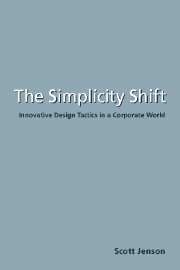The Simplicity Shift
High-tech products have historically had notoriously poor design. Fortunately, companies have recently started to embrace user-centered design practices. This transition hasn't been smooth; many companies have difficulty transferring good design into final, shippable product. There is a political/cultural disconnect between the outward corporate desire for good design and the internal corporate culture that implements it. The Simplicity Shift is about moving the company culture to value, discover and implement simplicity, and to create a well-designed product. For most companies, product design is not paramount; it is something locked into a "design department" and approached as a sub-task of the larger sequential process. For companies to truly create breakthrough, easy-to-use products, they must elevate design so that its terms and tools are shared by everyone in the team. Design is a strategic tool that thereby becomes a part of how every company employee thinks, acts--and most importantly--makes decisions. Product managers and professional designers will benefit from the tools and examples about making design work in a production company.
- Practitioner's book about making design work
- Lots of examples from real world projects
- Design exercises which illustrate the points made
Reviews & endorsements
'The conversational writing style and the excellent instructive examples make the book appealing not only to technology experts, but also to managers and to consumers of products and services who sometimes (or often) wonder why it is so difficult to use something …'. Computing Reviews
Product details
November 2002Paperback
9780521527491
182 pages
229 × 152 × 11 mm
0.25kg
Available
Table of Contents
- 1. Motivation
- 2. Vocabulary
- 3. Why is bad design such good business?
- 4. User blindness
- 5. Design interlude - redesigning a timer thermostat
- 6. Feature blindness
- 7. Design interlude - redesigning a digital jukebox
- 8. Innovation blindness
- 9. Design interlude - mobile phones
- 10. Conclusion.







